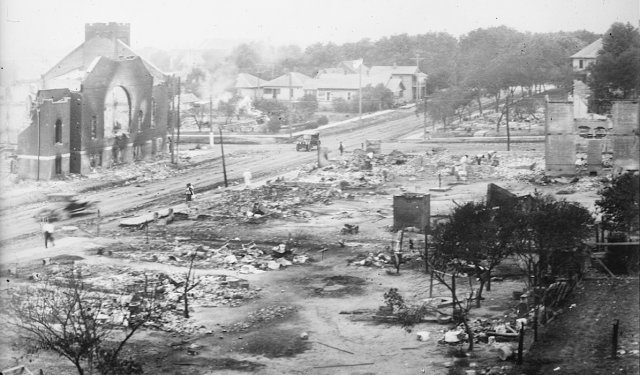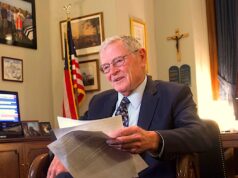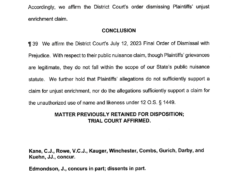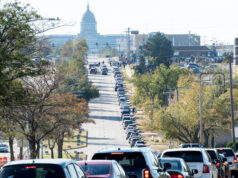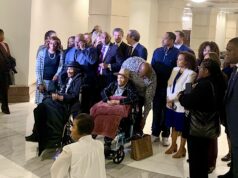
I’ve been writing about Oklahoma’s place in the American master narrative for a while now. My sense that we’re the repository for the nation’s distilled sins and griefs seems borne out again in the 21st century with the assault on the U.S. Capitol on Jan. 6. We know that two of the 20th century’s deadliest acts of white-supremacist terror took place in Oklahoma — in 1921, with the white mob assault on Greenwood in Tulsa, and in 1995, with the bombing of the Murrah Federal Building in Oklahoma City. Both were predicated on lies, as was this one.
To me, it’s not merely ironic but iconic that Oklahoma Sen. James Lankford was at the podium expressing his support for the lie under which the mob outside was operating at the very moment the U.S. Capitol Building was breached. Later, after hiding from rioters for hours, Oklahoma’s five House members emerged to vote to uphold this same lie. That they couched their vote in the language of the liars — “voting irregularities,” “election integrity,” “my constituents have questions” — doesn’t mitigate the enormity of the lie, or the fact that these members knew it was a lie, just as the white city fathers in Tulsa knew there was no “Negro uprising” in Greenwood in 1921.
The 1995 Oklahoma City Bombing was grounded in lies, too — the great foundational lie of white supremacy joined with anti-government ideology, white resentment, fear of loss of privilege and stature, just as the 2021 assault on the U.S. Capitol was. Oklahoma City Mayor David Holt has made clear he sees thousands of Timothy McVeighs in the Jan. 6 assault — and it’s true. McVeigh and his co-conspirators consorted with white-nationalist militiamen and borrowed their anti-federal-government language and ideology, but, at bottom, the OKC Bombing, just like the massacre in Tulsa and the assault on the Capitol, had its force of energy, its lit fuel of hatred seated in white supremacy.
The blueprint McVeigh used for the bombing was a white-supremacist polemic, The Turner Diaries. It outlines a bombing very like the Murrah bombing which, in the novel, sets off a race war that culminates in a white-supremacist nation. This was McVeighs’s goal, as it was Dylann Roof’s goal when he murdered nine Black Americans at a prayer meeting at Mother Emmanuel Church in Charleston in 2015, as it has been the goal of white supremacist assaults from the country’s inception.
The white mob assault on the Capitol is not unique. It’s not new. We’ve seen this before. From the sweeping terrorism of white mob lynchings to the mass assaults on Black communities in Wilmington, N.C., in 1898; in Chicago, Omaha, and Elaine, Ark., in 1919; in Tulsa in 1921 and Rosewood, Fla., in 1922: these white mob assaults are all grounded in white resentment, anger, fear and the great American lie that white Americans are the only true Americans —just as the assault on the Capitol was. To me, it’s the parallels between 1921 Tulsa and 2021 Washington, D.C., that are the most troubling — and the most instructive.
Coordinated and planned
The 1921 Tulsa Race Massacre was not a sudden explosion of uncontrolled mob violence any more than the assault on the Capitol was an abrupt eruption, unpredicted and unpredictable: both were carefully planned. Some say the assault on Greenwood was hatched by city fathers for months as they waited for the opportunity to execute it; others say the assault was a spontaneous event organized through the night of May 31-June 1 as city officials deputized white rioters and armed them or looked the other way as the rioters broke into the armory and pawnshops to arm themselves. Whatever the timeline of preparations, it’s clear that the dawn invasion of Greenwood was both coordinated and planned, just as the Capitol assault was planned. That not everyone who marched from President Donald Trump’s rally to the Capitol knew of the planning, or took part in it, doesn’t eliminate the fact that the planning took place — and was done with the active encouragement of white elected officials, just as the assault on Greenwood was aided by collusion and encouragement from the centers of white political and business power in Tulsa a century ago.
The lie of a “Negro uprising” in Tulsa went out via newsfeeds of the day — telegraph and telephone — just as the lie of the “stolen election” went out on social media. This wildfire lie accounts for the stunning numbers of armed whites, estimated at 10,000, who swarmed into Greenwood at dawn on June 1, 1921. How did so many gather so quickly, not only from within Tulsa but from surrounding communities and oilfield towns? In 2008, when I was visiting the Cushing Public Library for a discussion of my novel about the Tulsa Race Massacre, Fire in Beulah, an older white woman told us how her mother described seeing dozens of automobiles crammed with white men roaring past her house, racing toward Tulsa, on the night the massacre began. How did they know? There was no radio then, no television. The telegraph and telephone were their Twitter and Parler.
Then, too, it’s impossible to minimize the role of white newspapers and journals, which were essentially the mass media of the day. In Tulsa, the local newspapers fomented fear, jealousy, and anger among whites, perpetuating the belief that white dominance was under threat from Black Americans, and they did this not only in the hours leading up to the massacre but for decades before and after. Overt anti-Black racism was common in white newspapers across the country. If you go to newspaper archives anywhere and read the editorial pages and news articles from the era, you’ll see the boldness of their racist language: they didn’t bother with dog whistles in those days — there was no need. In the same way, today’s right-wing media, from Fox News to Breitbart to AM talk radio, have been massaging white fear and resentment for years — most openly, loudly, with a very particular lie about a stolen election, in the months since Nov. 6.
An unwillingness to bring whites to justice
Here’s another parallel, a small but significant one: in the early morning hours of June 1, as the white mob gathered along the Frisco tracks in Tulsa preparing their assault on Greenwood, uniformed law officers stood in formation to hold them back — a feeble stand by a few dozen officers, who were quickly overrun by the sheer numbers and force of the mob, just as the Capitol police were overrun by white rioters on Jan. 6. In 1921, the white mob had been gathering for hours. The law enforcement effort to contain it was far too little, too late. In 2021, we were almost in the same position. How very close we came.
But to me the most dangerous parallel is how the white powers-that-be in 1921 Tulsa — the city fathers, government officials, wealthy oilmen and merchants — wanted no reckoning, no investigation, no help in caring for the wounded or the thousands of Black Tulsans left homeless by the massacre. They wanted no outside eyes, no being-held-accountable. In the end, no charges were brought against white perpetrators for the murderous violence unleashed on Greenwood, and even the few charges against white rioters for possession of stolen property were eventually dropped.
This unwillingness to bring any white participants to justice led, as we know, to the Great Forgetting, that phenomenal accomplishment of powerful whites in government and business who refused to allow for the truth to be told or the guilty to be held accountable. They caused an entire nation to, first, not think about it (“this is a time to heal”), and then not speak about it (“let’s not talk about such things: it’s bad for business”), and finally to not remember it at all. And so here we are 100 years later, with wounds unhealed in Tulsa, unhealed in Oklahoma and unhealed, indeed, across the entire United States.
There are, of course, so many differences between 1921 and 2021. The targets of the assault in Washington were not only Black Americans but also white elected officials, their staffs, and law enforcement officers whose job it was to protect them. Today we have video evidence searing the brutality of the violence in our minds so that it has been harder for those who supported it to lie about what happened and who caused it (although this has not stopped many from trying). Our mass media today is less openly racist than in the early 20th century, so it’s possible now to turn to the news and find accurate accounts. Today, unlike 100 years ago, many members of government and law enforcement are calling for accountability. But not all, you see.
Here in Oklahoma, our representatives in the U.S. House and the Senate are not calling for accountability, for themselves or others. Lankford has apologized to Black Tulsans for being blind to how they would perceive his questioning of election results. He hasn’t apologized for the fact that his questioning of results in heavily Black districts actually is racist. It isn’t a case of misguided perceptions by the Black community in Tulsa, it’s a well-worn chapter in the long playbook of Black voter suppression. Nor has Sen. Lankford apologized for the lie itself — the cold, conscious lie about a stolen election which he and his cohorts helped perpetuate for months. They haven’t admitted that the violence at the Capitol ensued directly from their lie, or acknowledged the white supremacy that underpins it, and that’s what has me worried.
It’s not the differences between 1921 and 2021 that have me heartsick and filled with dread. It’s how we are still so much the same.








